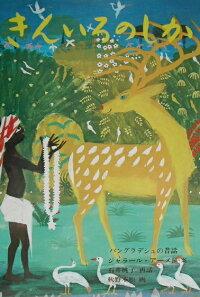The appeal and reviews of "The Golden Deer": A moving story and beautiful visuals

The Golden Deer: Life Lessons from the Jataka TalesThe Jataka Tales: The Golden Deer, released in November 1962, was a theatrical animation that moved audiences with its short but profound content. This work is an original story for the anime, and was produced by Gakken Films under the planning of the Suzuki Academic Foundation. It was directed by Watanabe Kazuhiko, with a screenplay by Watanabe Kazuhiko, cinematography by Takeuchi Norio, art by Shimizu Kozo, and music by Kinoshita Tadashi. In its short length of just 11 minutes, the story conveys one moral lesson. Story Summary"The Golden Deer" is based on the story of "The Golden Deer," one of the Jataka tales. The Jataka tales are a collection of Buddhist tales that depict the life of the Buddha in a previous life. In this work, a golden deer appears and the story unfolds in which the deer teaches people a lesson. The story is set in the forest of a certain kingdom. There lived a beautiful golden deer. This deer was loved and respected by both the animals and people of the forest. However, one day, the king gave the order to capture this golden deer. The king wanted to use the golden deer's antlers as an ornament. The deer tried to escape the king's orders, but eventually appeared before the king. The deer pleaded with the king, "Instead of killing me, please save my life. And as proof that you have saved my life, please spread my teachings instead of using my antlers as an ornament." The king was moved by these words and decided to save the deer's life. In order to spread the deer's teachings, the king enacted a new law and began to protect the animals of the forest. Appeal of the workThe greatest appeal of "The Golden Deer from the Jataka Tales" is the profound lesson it depicts in such a short time. The importance of "saving lives," which the golden deer appeals to the king, is a universal message that is still relevant in modern society. The beautiful appearance of the deer and its kindness move the audience. Furthermore, the Buddhist teachings that underlie the story also add depth to the work. Another attraction of this work is its beautiful animation. Although it was made in 1962, its sense of color and the expression of movement are still beautiful even when viewed today. In particular, the depiction of the golden deer has the power to capture the hearts of the audience. The technique of Shimizu Kozo, who was in charge of art, and the beautiful melody of Kinoshita Tadashi, who was in charge of music, further enhance the story. Production background and staff"The Golden Deer" was produced by Gakken Films under the planning of the Suzuki Academic Foundation. The Suzuki Academic Foundation is a foundation that aims to promote education and culture, and this film was produced as part of that effort. Director Watanabe Kazuhiko, who also wrote the screenplay, succeeded in portraying the central moral of the story. Cinematographer Takeuchi Norio produced beautiful images, and art direction by Shimizu Kozo enriched the worldview of the work. Music by Kinoshita Tadashi provided beautiful melodies that added depth to the story. With the cooperation of these staff members, "The Golden Deer" was completed. Evaluation and influence of the work"The Golden Deer" was highly praised when it was released. In particular, the profound lessons and beautiful animations depicted in a short time frame moved many audience members. This work also helped to spread the teachings of Buddhism. The Jataka Tales are a collection of stories contained in Buddhist scriptures, and among them, the story of "The Golden Deer" is particularly famous. Through this work, many people had the opportunity to come into contact with the teachings of Buddhism. This work also influenced later animation works. In particular, the technique of depicting deep lessons in a short amount of time was adopted by many works. Also, the fusion of beautiful animation and music has been inherited by later works. "The Tales of the Golden Deer" can be said to be a milestone in the history of animation. Recommendations and how to watch"The Golden Deer" is a short story that teaches a deep lesson, and is recommended for everyone. It is a good opportunity to teach children the importance of life and kindness. It is also interesting for those who are interested in Buddhism. It is also recommended for those who are interested in the history of animation and beautiful images. This work is now available on DVD and online, especially on the Gakken Films official website and on video streaming services. Please watch this work and enjoy its profound lessons and beautiful animation. summary"The Golden Deer" is a short film that was released in 1962, but it teaches a profound lesson. The golden deer appeals to the king about the importance of "saving lives," a universal message that is still relevant in modern society. The fusion of beautiful animation and music also moves the audience. This work helped to spread the teachings of Buddhism, and influenced later animation works. Please watch this film and enjoy its profound lesson and beautiful animation. |
<<: Jataka Tales: The White Elephant - Explore the moving story and profound lessons
>>: Dad Loves Mom: A thorough review of a moving anime masterpiece that depicts family ties and love
Recommend
American Horror Story Season 2 trailer will be available on Hulu on July 21
Today (July 1), the horror series "American ...
"Fast and Furious 9" released a preview trailer, and Dom lived a happy "retirement" life
Today (January 29), the tenth film in the "F...
R-rated animated series "Sausage Party: Foodtopia" officially announced and will be released on July 11
Today (June 12), the official trailer for the R-r...
Netflix's new animation "Ranma 1/2" cast revealed Conan voice actor
Rumiko Takahashi's classic manga "Ranma ...
Tom Cruise's Top Gun 2 adds another big-name star, Ed Harris joins
Tom Cruise's Mission: Impossible 6 will be re...
The movie "Rise of the Teenage Mutant Ninja Turtles" is confirmed to be introduced in mainland China, and the classic IP will be upgraded and returned with a new animation
The new animated film "Rise of the Teenage M...
Netflix's live-action series "Cowboy Bebop" revealed
Netflix's Asian YouTube channel has released ...
The latest trailer for the TV animation "Yo-kai Watch" will officially start airing on April 9
Level-5's well-known anime and game IP "...
The Melancholy of Haruhi Suzumiya Season 2: A journey of evolution and deepening that exceeds expectations
The Melancholy of Haruhi Suzumiya (Season 2) - De...
The new OVA trailer of "Kaguya-sama: Love is War" will be officially released on May 19
The new OVA of the popular anime "Kaguya-sam...
The new Batman poster is released, revenge is coming to Gotham
Recently, a new poster of "The New Batman&qu...
Re-creating a new star! Akimoto Yasushi's new idol project "22/7" TV animation new trailer released
Yasushi Akimoto, the famous Japanese all-round en...
Michelle Yeoh to star in the Russo Brothers' new film Electric Kingdom, to start filming this fall
According to Deadline, Michelle Yeoh, Stanley Tuc...
Makoto Shinkai's animated film "Suzuya's Door Lock" released its first trailer
Toho Films has released the trailer for Makoto Sh...
The appeal and reviews of PHANTOM - The Legend of the Phantom Brave - RETURN THE SKY: In search of a return to the sky
The appeal and reviews of "PHANTOM - The Leg...









